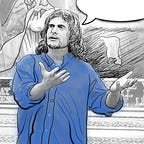The Man Who Killed Santa Claus
Santa Claus was killed in 1932 in Mesa, Arizona. Naturally this tragic event took place during the Great Depression. The horrific occasion was witnessed by hundreds and in fact was the climax of a Christmas parade. Traumatized children broke into uncontrollable sobbing as the tears fell like waterfalls.
In 1932, the Great Depression had cast dark economic clouds across the nation and the rural community of Mesa was hit hard by financial woes and its citizens were in dire straits. Things were so bad that it looked as if the annual Christmas parade would have to be cancelled. That was when the colorful editor of the Mesa Tribune, John McPhee, came up with a flamboyant promotional scheme to save the Christmas parade.
McPhee had the notion of beginning the parade beside an open field on the outskirts of town. A small plane would circle overhead and Santa Claus would skydive into town, arriving not by reindeer drawn sled but floating down from the heavens beneath a billowing white canopy. Once he had landed in the open field Santa would unharness to thunderous applause, before triumphantly leading the Christmas parade through town.
This event took place only five years after Lindbergh had crossed the Atlantic and
aviation was still considered a risky venture. Merchants, wounded by dismal financial times, were willing to back any plan which might boost lagging Christmas sales. A small plane was rented and a stunt man was found who agreed to undertake the daredevil act, leaping from an airplane armed with only a Santa Claus suit and a parachute.
The morning of the big event, shortly before the parade itself, Santa was nowhere to be found. An anxious McPhee paced and stalled, sending people everywhere in search of the fugitive Santa. It was one of the elves who discovered Santa plastered to a bar stool in a local tavern trying to drink up some courage. The wayward Santa Claus was too intoxicated to stand. Determined not to cancel the flamboyant beginning of the heavily promoted Christmas extravaganza; McPhee asked the local merchants for volunteers to make the Santa jump. There were no takers. McPhee had to admit that he himself found the task a little daunting.
Desperation forced a desperate plan. McPhee put the Santa Claus suit on a department store dummy. The mannequin would be pushed from the airplane and float down into the field. McPhee, wearing a second Santa Claus suit would be hiding in the tall grass and leap out, greeting the crowd and quickly starting the Christmas parade before anyone could ask questions.
The moment arrived. A sizable crowd gathered on the edge of the field and all grew silent, waiting anxiously, when the sputtering of the approaching aircraft could be heard. Squinting into the sun, the people cheered when the tiny metal airplane carrying Santa Claus could first be seen. The pilot circled low above the crowd, hovering so close above the heads of the astonished spectators that they were able to see the
department store dummy wearing the red suit standing in the doorway, his white beard flapping in the breeze. The plane ascended in a gradual spiral and at its peak the mannequin Santa was pushed from the doorway. The static line pulled but the chute failed to open. Santa fell from the sky, dropping, dropping, dropping to the earth in a red and white blur. As he plummeted to earth, white beard, red cap, and tangled chute waving wildly behind him, the children screamed. Santa landed in the field with a horrific splat. Women fainted.
Without the open parachute to create a wind drift, the pilot had badly miscalculated where the mannequin would land. By the time McPhee had run to where Santa crashed most of the crowd had already started to leave and were trying to comfort their sobbing children. McPhee leapt over the mangled Santa and went “Ta-Da” but no one was watching. The parade went on as scheduled but the most of the crowd went home long before it was over. Those few who remained were quiet. It almost seemed like more of a funeral procession than a parade. McPhee spent most of the next few weeks laying low. Christmas sales did not improve. McPhee continued a long career as a civic leader until his death forty years later and did not mention the incident often himself. Still, the headline of his obituary could not help but mention the demise “of the man who killed Santa Claus.”
